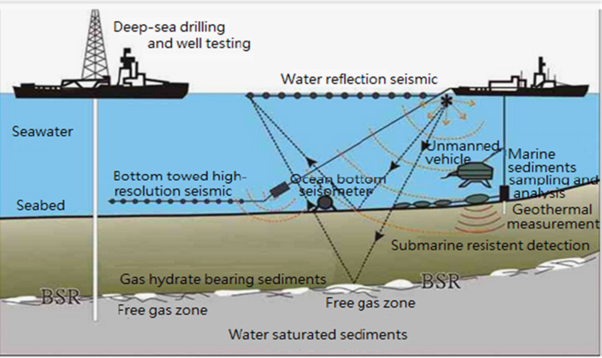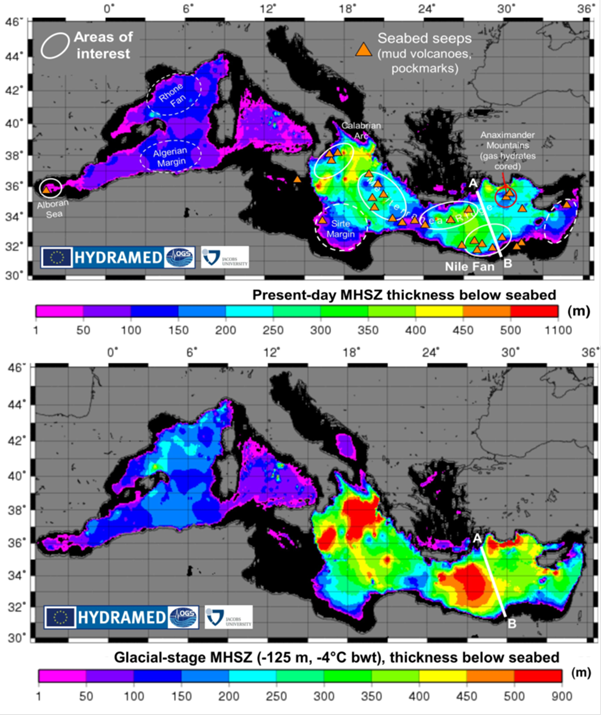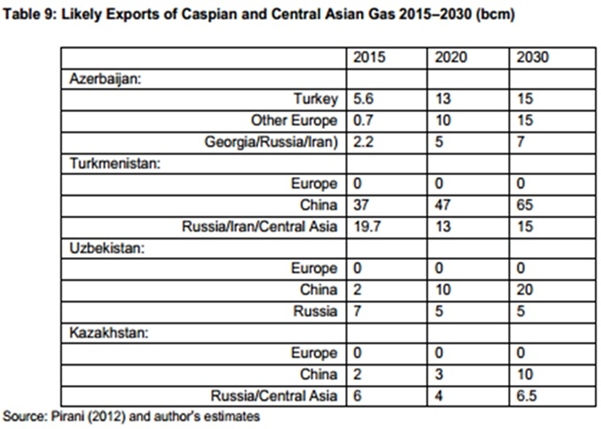By Athanasios Pitatzis
In today’s article we cover methane hydrate, explain what it is, where it is located on the planet, with which technologies it is mined, what future lies for it, what its geopolitical footprint on the planet in the next 20 years will be and if it can change the correlations worldwide.
The existence of methane hydrate has been known since the 1930s but only in the last 10 years has it become a subject of serious consideration as a possible source of energy from fossil fuels for the future. It is now possible to calculate the total amounts available with some confidence. [1]
Methane hydrate is formed when water and methane gas are combined at temperatures below 10 degrees Celsius and pressures greater than 30 bar, or 30 times normal atmospheric pressure. The methane is surrounded by water molecules and trapped in a molecular cage. Chemists therefore call this kind of molecular structure a clathrate (lat. clatratus = with bars, caged) [1]
The methods to extract them are three:
- Flooding with water requires immense amounts of energy, which makes it uneconomical.
- With depressurization and
- The injection method with CO2 [1]

Methods of extraction of Methane Hydrates, Source of the photo: Resources, M. (2014). world ocean review., http://worldoceanreview.com/
If you want to read more extended information on methane hydrate and its methods of extraction, you can find this information on this link, specifically in chapter 3 of the paper Resources, M. (2014). World ocean review: http://worldoceanreview.com/wp-content/downloads/wor3/WOR3_english.pdf

Source of the photo: Ice, F., & Steering, I. (2012). 8 th International Workshop on Methane Hydrate Research & Development Sapporo 2012 Fiery Ice International Steering Committee CONTENTS, (June).
Hydrate Global Reserves
“Gas hydrate is one of the emerging clean energies of the 21st century. The prospective methane contained in global gas hydrate Reserves is 21,000 trillion cubic meters, which are about 100 times the total natural gas reserves in the current world. Assuming 10% of the total reserves were exploited, it can be used for about 600 years, as shown in Tables 9 and 10.’’ [2] (You can observe the tables 9 and 10 below)

Methane Hydrates Reserves, Source: http://www.dailymail.co.uk/sciencetech/article-2292555/Japanese-breakthrough-country-extract-fuel-ice-reserves-locked-beneath-coast.html#ixzz2NSgeQfQe
Rating for the reserves cannot be done safely because we are talking about a new form of energy. We can mention what the main trend is in many reports, many experts claim that our planet contains large quantities of methane hydrates. Above you observed one hypothesis for the reserves from a paper which was published in the scientific website www.sciencedirect.com.

Source: Lu, S.-M. (2015). A global survey of gas hydrate development and reserves: Specifically in the marine field. Renewable and Sustainable Energy Reviews, 41, 884–900. doi:10.1016/j.rser.2014.08.063
Japan: The first country which produced natural gas from methane hydrates
“Japan Oil, Gas and Metals National Corporation (“JOGMEC”, Headquarter: Minato-ku, Tokyo, President: Hirobumi Kawano), which has been conducting a flow test from March 12 in the first offshore production test off the coasts of Atsumi and Shima peninsulas, ended the flow test on March 18, 2013.”[3]
You can read more specific details about this operation in these links:
http://www.jogmec.go.jp/english/news/release/news_01_000005.html?recommend=1
http://www.jogmec.go.jp/english/oil/technology_015.html
http://www.jogmec.go.jp/english/news/release/news_01_000006.html?recommend=1
As an author I most like to provide you with graphics instead of many words, observe the images below for the exploration of methane hydrates in Japan.

‘The new shale gas': An aerial view shows deep-sea drilling vessel “Chikyu” in the Pacific, off Aichi Prefecture, central Japan, as it hunts for methane hydrate reserves to exploit
Source: http://www.dailymail.co.uk/sciencetech/article-2292555/Japanese-breakthrough-country-extract-fuel-ice-reserves-locked-beneath-coast.html#ixzz3JByvbMTg

Source: http://www.jogmec.go.jp/english/oil/technology_015.html

Source: Lu, S.-M. (2015). A global survey of gas hydrate development and reserves: Specifically in the marine field. Renewable and Sustainable Energy Reviews, 41, 884–900. doi:10.1016/j.rser.2014.08.063

Source: Lu, S.-M. (2015). A global survey of gas hydrate development and reserves: Specifically in the marine field. Renewable and Sustainable Energy Reviews, 41, 884–900. doi:10.1016/j.rser.2014.08.063
Greece leads Europe Energy Security for the next decades through the existence of Methane Hydrate in Greek Economic Zone (EEZ)

Source: Praeg, D., Geletti, R., Wardell, N., Nazionale, I., Sperimentale, G., Gigante, B. G., … Migeon, S. (2011). THE MEDITERRANEAN SEA : A NATURAL LABORATORY TO STUDY GAS HYDRATE DYNAMICS ? Vikram Unnithan, (Icgh).
As you can observe from the maps above of the entire Mediterranean region the majority of the possible recoverable methane hydrate deposits are in EEZ of Greece and in the Levantine Base in Egypt. It is an opportunity for the exploration of Methane Hydrates for the European Union for several reasons, including the following:
- Change the European Energy mix to more environmentally friendly natural resources through the decrease of the use coal and oil and an increase in the use of natural gas from methane hydrate- Urban Development- Unlimited safe supply of natural gas to the European industry.
- Independence from Russian Natural Gas
- Increase the geopolitical impact of the European Union through common defense and energy policies
Some facts about the European Union and Methane Hydrates that can be crucial for the future are:
- Europe until the given date is confused and focuses its attention on internal affairs. This can be catastrophic because if the EU wants to enter and explore the possibility of extracting methane hydrates it is at best lagging 20 years behind the USA and 10 behind Japan in terms of Technology, Research, Legislation and Geopolitical planning.
- According to Japanese scientists that complete the first successful drilling operation on methane hydrates this process will be commercially available in the next 6 years until 2018-2020. My personal estimation is that within the next 3 years the process will be commercially available. This hypothesis nevertheless explains the latest American geopolitical actions and steps, such as the focus of American strategy in South East Asia, maybe not only in China but also the possible commercially recovery of enormous methane hydrate deposits (refer to the map above for the methane hydrate deposits). This situation concludes that Europe’s geopolitical blindness will lead this historic place to being an energy hostage by one of the major geopolitical actors.
The main message is Greece’s Exclusive Economic Zone can become the key for European Energy Independence.
Western Alliance for the exploration of Methane Hydrates, USA – Japan – Greece
We propose an alliance in scientific and cooperation level of these 3 countries as they possess possible commercially recoverable methane hydrate deposits. Also, these countries have common interests through this alliance, such as:
- Energy Security
- Increase of their GPD
- Accomplishment of their Geopolitical Goals and Plans
- Increase their competitiveness in their national industries through low-cost electricity
We also want to mention that Greece does not have the capabilities of the USA nor Japan but can provide these countries with the opportunity to perform the first commercial drilling operations within the Greek Exclusive Economic Zone due to the proximity of the Mediterranean Sea hence making these specific operations safer. Moreover, the USA and Greece have as a common goal the safe energy security of the European Union.
The geopolitical footprint of methane hydrates
If over the next 10 years and by 2020 the hydrates methane extraction technology becomes commercially exploitable and extraction costs viable, geopolitical changes will be tectonic, including:
- Total independence of Japan by imports of natural gas, partly perhaps the independence of China as well.
- Gradual crowding from countries which produce conventional forms of hydrocarbons such as Saudi Arabia and Qatar, but not Russia, which has several possible areas with existing deposits of methane hydrates.
- Future supply of the European Union’s natural gas production from methane hydrates from the Black Sea and the Southeast Mediterranean.
- Increase of the geopolitical importance of the following areas due to the presence of methane hydrates: Southeastern Mediterranean, Southeast Asia, the Black Sea, Caspian Sea, North Sea and of course the seas around India which appear to contain large amounts of methane hydrates.
Finally we would like to mention that the journey is now starting to look exciting so fasten your seat belts, the story of methane hydrates has now started and can change life on our planet as we know it today.
Some Personal Estimations
European energy supply from several sources as the political goal is beneficial but in terms of logic it is a joke. For the next decades the only sources of differentiation of supply in Europe in terms of natural gas is LNG from the USA and maybe Southeast Asia and the Southeast Mediterranean with the demand to increase if we consider that Europe now promotes natural gas for public and private transportation. (Observe the graph below)

Source: Reducing European Dependence on Russian Gas: Distinguishing natural gas security from geopolitics, Oxford Institute for Energy Studies, October 2014, Ralf Dickel, Elham Hassanzadeh,, James Henderson, Anouk Honoré, Laura El-Katiri, Simon Pirani, Howard Rogers, Jonathan Stern & Katja Yafimava
“Michel Collon a Belgian writer, journalist, and historian claims that if you want to control the world, you must control the oil, all the oil everywhere in this planet.”
My estimation for the period after 2020 is that the geopolitical trend-message which can dominate the policy makers worldwide will be:
“ If you want to control the world, you must control the methane hydrate deposits, all the methane hydrates deposits everywhere in this planet.”
Finally don’t forget my general message through this article:
The best way to predict the future is to create it.. Abraham Lincoln
[1] Resources, M. (2014). world ocean review, http://worldoceanreview.com/
[2] Lu, S.-M. (2015). A global survey of gas hydrate development and reserves: Specifically in the marine field. Renewable and Sustainable Energy Reviews, 41, 884–900. doi:10.1016/j.rser.2014.08.063
[3] JOGMEC, Japan Oil, Gas and Metals National Cooperation, http://www.jogmec.go.jp/english/news/release/news_01_000005.html?recommend=1
Athanasios Pitatzis, Production and Management Engineer, Democritus University of Thrace, 2014-2015 Postgraduate student in TEI Eastern Macedonia and Thrace (Kavala) in the Masters of Science in Oil and Gas Technology (http://msc.petrotech.teikav.edu.gr/). I write articles on Greece within a variety of internet web portals in the fields of Geostrategy, Geoenergy and energy policy. Also I possess a Certificate-Seminar E-Learning on Geopolitics and Security Issues in the Islamic Complex Turkey-Middle East from Ethnikon and Kapodistriakon University of Athens. Member of Society of Petroleum Engineers, SPE Section of Kavala (http://www.spe-kavala.org/ ) (http://spe.org/ )
It was first published in the energy newsletter of the website www.eiranews.com
The original article written by myself in Greek can be found on the following link: http://energypress.gr/news/Ydrites-Methanioy:-To-kaysimo-toy-mellontos-kai-to-gewpolitiko-toy-apotypwma-ston-pagkosmio-energeiako-harth





























